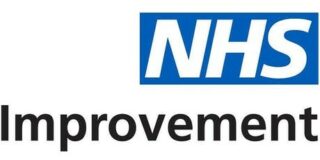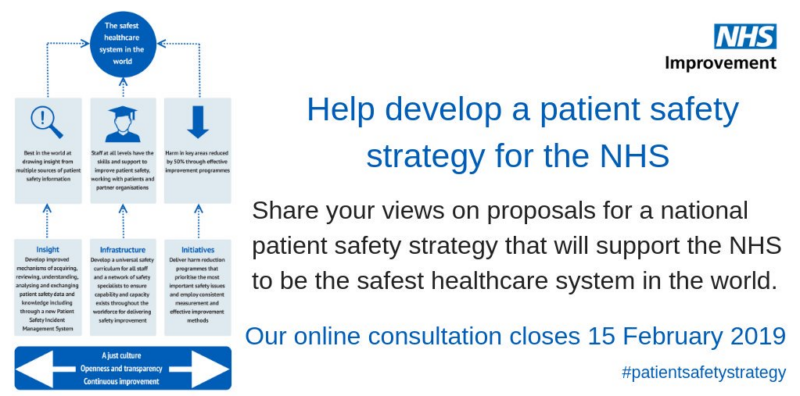 The NHS is admired around the world as one of the safest and most productive healthcare systems there is. However, we recognise there is much more that can be done for our patients and want to support the entire NHS to be a system that can continuously learn and improve to deliver ever safer care.
The NHS is admired around the world as one of the safest and most productive healthcare systems there is. However, we recognise there is much more that can be done for our patients and want to support the entire NHS to be a system that can continuously learn and improve to deliver ever safer care.
To support everyone working in the NHS and related organisations to achieve that, we have come up with a set of proposals for an ambitious national patient safety strategy that we are currently consulting on.
Just like Q itself, our proposals build on the vision set out by the Berwick report in 2013. For some aspects we are proposing to continue and evolve existing good work, such as the patient safety collaboratives and the creation of a new patient safety incident management system. But we are also looking to introduce new measures such as a national patient safety curriculum and the establishment of a network of patient safety specialists to be identified patient safety leads within their organisations.
The recently published Long Term Plan sets out an ambitious roadmap for the NHS over the next ten years. We must ensure that patient safety is the golden thread in its delivery, from everyone getting the best start in life to ensuring people are supported to age well.
We must ensure that patient safety is the golden thread in its delivery, from everyone getting the best start in life to ensuring people are supported to age well.
The Long Term Plan rightly acknowledges the huge successes that the NHS has made in recent decades including improving the safety of mothers and babies and male suicide being at a 31 year-low.
But there is a huge potential to do even more. Our data tells us that we could save many lives and half a billion pounds a year by improving patient safety and reducing harm. I know that achieving this will be a tall order, but patients deserve and expect us to be ambitious.
Our proposals are very much the skeleton that the final strategy will be formed around. We therefore need people like you to give us feedback and tell us what you think based on your own knowledge and practical experience. We also want to hear ideas on what you think we could do from our central position as the national patient safety team to support the NHS to be the safest healthcare system in the world.
The Q community is ideally placed to provide this input. Your range of roles, the organisations you represent, your commitment to the principles of continuous learning and improvement, and levels of experience, make members of Q an ideal collective source of knowledge for us to test our proposals, and help ensure our final strategy will offer the right and most productive approach for today’s NHS.

We would be most grateful if each of you can please take the time to visit our consultation web pages and share your views, feedback, ideas and opinions via our online survey. The survey remains open until 15 February 2019.
As part of the consultation we are running a series of focus groups across the country. One element of our strategy is a patient advocate for safety role and we are running a focus group on this topic in London on 20 February 2019. We have recruited patient representatives but we would also like some staff representatives to attend. If you are a Q member who is a patient and public involvement lead or a patient safety lead in an acute Trust and would be interested in taking part, please contact Wayne Robson in the NHS Improvement Patient Safety Team by emailing wrobson@nhs.net by 6 February 2019. Please note places are limited.
Thank you for your support.
Comments
Carol Munt 1 Feb 2019
I am interested in how you recruited your patient representatives for the focus group on the 20th February.
Thank you
Carol Munt
Isabel Ho 2 Feb 2019
I m interested to know how you apply safety II and human factors approach in safety. Also interested in the cost and values of all sorts of incident reporting mechanisms and their effectiveness in reducing harm supported by meaningful data.
Aidan Fowler 5 Feb 2019
Hi Carol
Thank you for your question about the focus group.
We have been collaborating with our patient representatives to identify attendees for the focus group from a variety of organisations. We know from experience that our ability to absorb detailed feedback from a focus group or workshop is maximised when the group is smaller as this enables everyone to be heard and for us to have detailed discussions with people about their views. In order to allocate limited places fairly, and ensure we hear a wide variety of perspectives, we have had to limit the spaces we can offer to any single organisation.
The focus groups are just one of the ways we are gathering feedback on the strategy. We also have an online consultation which is open until the 15th Feb https://improvement.nhs.uk/resources/national-patient-safety-strategy/, and we are working with some local Healthwatch groups to support them to host their own discussions.
Kind Regards
Aidan
Aidan Fowler 12 Feb 2019
Hi Isabel
Thank you for your query.
We very much agree that understanding of human factors and ergonomics are a fundamental part of improving patient safety. That’s why we have signalled the need to include training and education in human factors and ergonomics as a key part of the proposed safety curriculum we describe in our strategy consultation. We apply these concepts in our work centrally as well, looking for ways to support staff to work safely in response to incident reports. You’ll see many examples here in terms of Alerts https://improvement.nhs.uk/resources/patient-safety-alerts/ and other national actions https://improvement.nhs.uk/resources/patient-safety-review-and-response-october-2017-march-2018/ We tend not to use the term human factors in explaining why one issue can be designed out, one issue can’t but can have the risk reduced through measures that are tailored to the causes of the issue in terms of human factors understanding. Our challenge in making this visible is one of the key issues the strategy is trying to address; unfortunately there is some fairly widespread misunderstanding of the term itself and we still see widespread examples of incidents being described as ‘caused’ by human factors, or human factors being thought of as synonym for teamwork, etc. You can also see examples at a policy level, we expect human factors principles to be similarly applied in locally led investigations.
Safety 2 is a relatively new field, but one which we are very keen to explore and exploit. We intend to support the reporting of things that go well through our new patient safety incident management system which will replace the National Reporting and Learning System (NRLS). That can’t be the whole story however. More routine data on the success of healthcare activity will be necessary and clearly the uptake of digital technologies can support that. Examples already in use locally include recording the success of medication administration in community services to understand more about what supports teams to ensure all patients receive the medication they need.
Estimating the benefits of incident reporting is incredibly difficult, particularly in relation to local incident reporting; as you’ll doubtless be aware of from your own local experience, the value depends on the local response to them, but we can see promising feedback from staff in the NHS Staff Survey in terms of belief that their reports are used to take action to improve safety. At a national level, the NRLS currently costs just over £2m a year to operate, but we have estimated that the insight we derive from this work saves something like 80 lives and almost £7m in treatment costs per year. While these figures are necessarily estimates, we believe they are conservative ones based on understanding of the strengths of barriers required by alerts and their current levels of implementation, and so we are confident that the existence of a national reporting system more than pays for itself both directly and indirectly.
Our processes are very much focused on the value a national system can add, and its ability to spot patterns that are not visible at a local level – see the links above. You’d be very welcome as a guest observer at our internal and external panels for escalating new and under-recognised issues if you’d like to see our work in action.
Regards
Aidan
Thomas John Rose 12 Sep 2024
Hi. No reply to my 2 previous comments. The awards ceremony at Worcester today has prompted another comment from me. I'm in the process of designing a Quality and Patient Safety Management System for a Trust. This new design will include a very advanced error reporting system. The design will be in compliance with the new standard BS ISO 7101:2023. I'm sure that that won't trigger a reply!
Regards Tom
Thomas John Rose 14 Mar 2019
Any new strategy must, in my view, include a focus on process management in the NHS. I have done research in this area.
Regards
Tom Rose
Thomas John Rose 17 Jun 2020
Aidan, I'm really encouraged that the new National patient safety syllabus 1.0 includes process mapping, although I'd prefer to call it process visualisation. The syllabus also includes almost all elements of what industry call Process Management. I think that the 'step change' in thinking about safety will be a major step forward. Traditional methods of process mapping should be avoided. Those advocated by the Q SIG 'Process Visualisation' are worth consideration.
Regards
Tom Rose